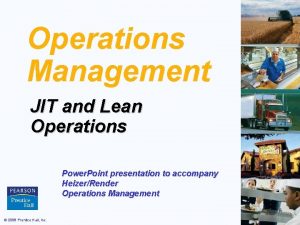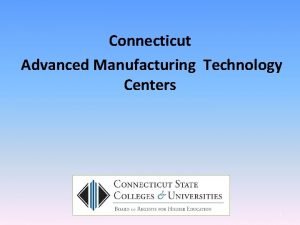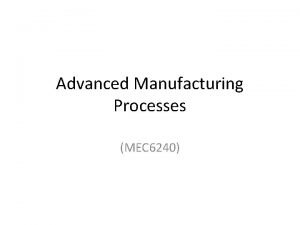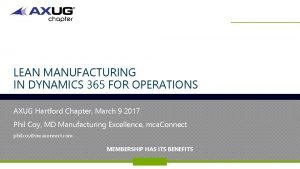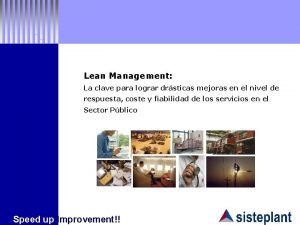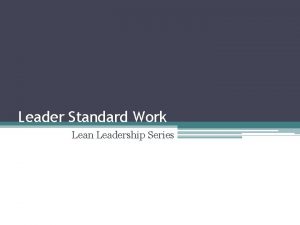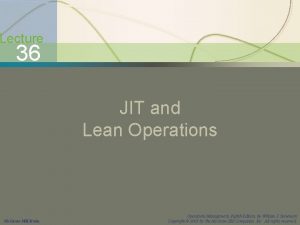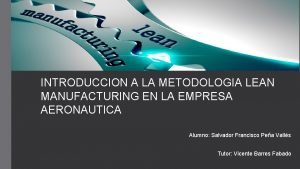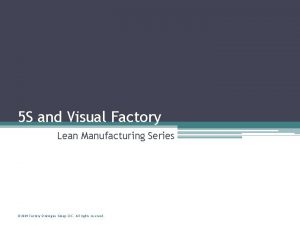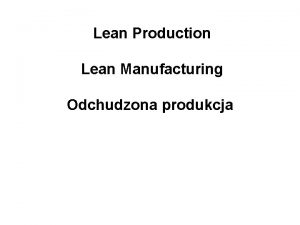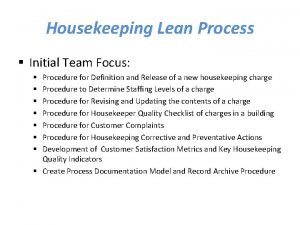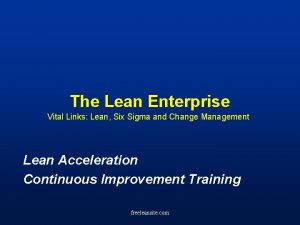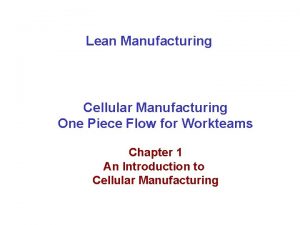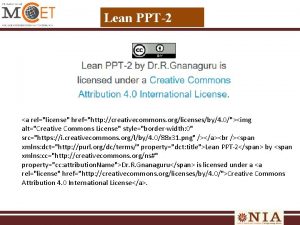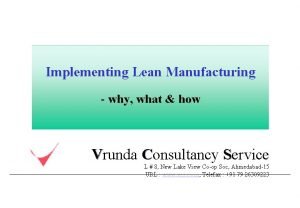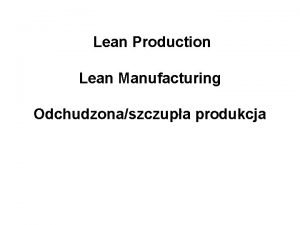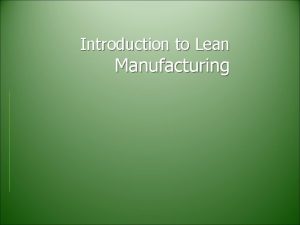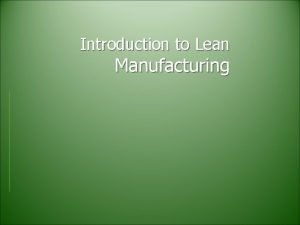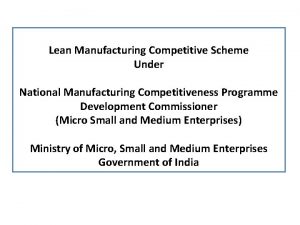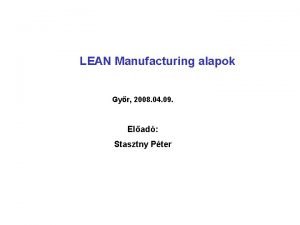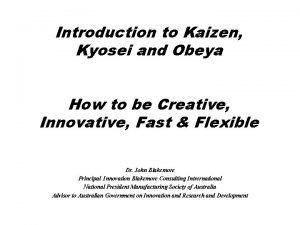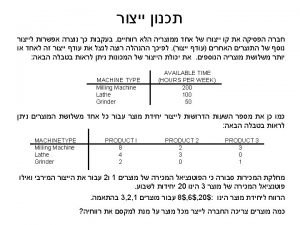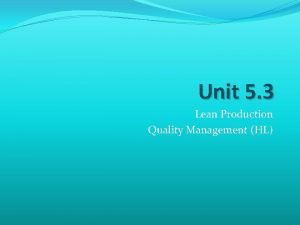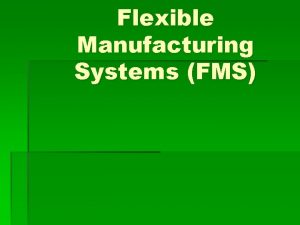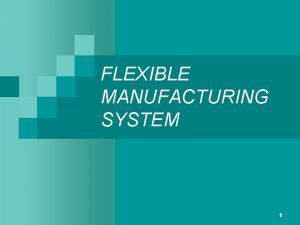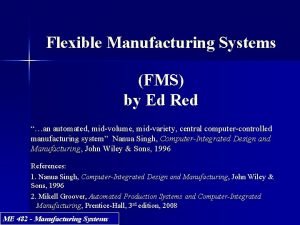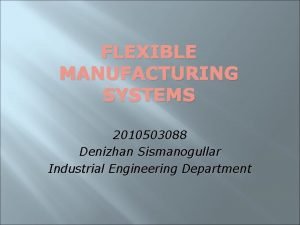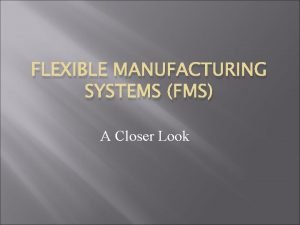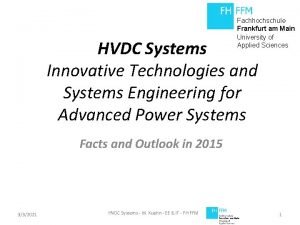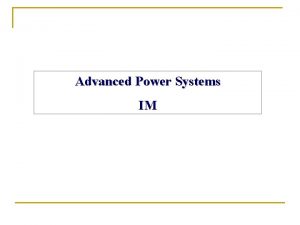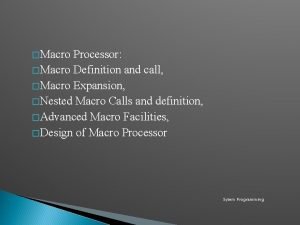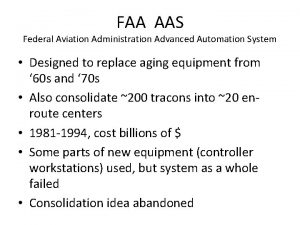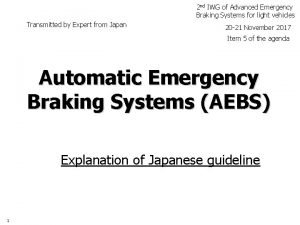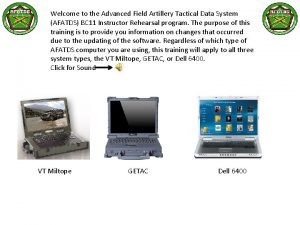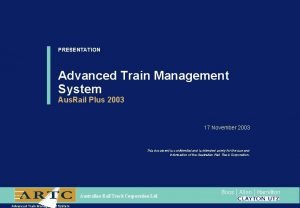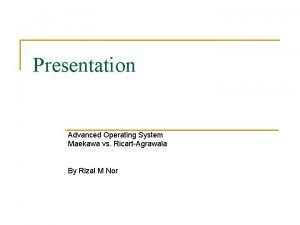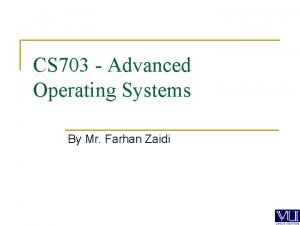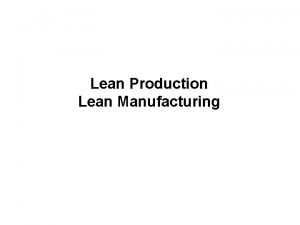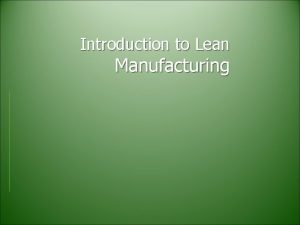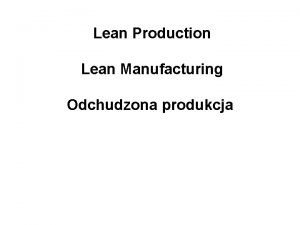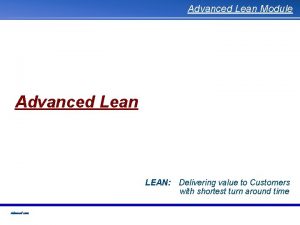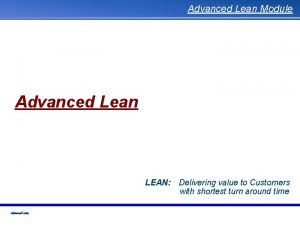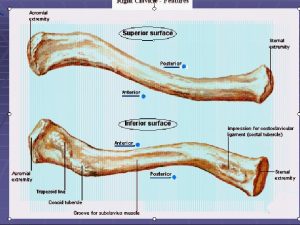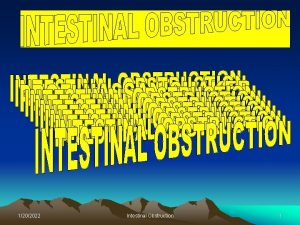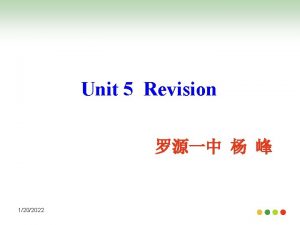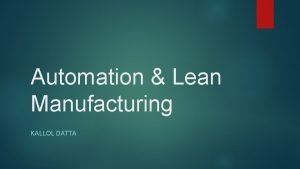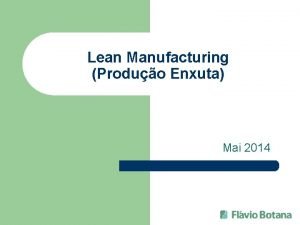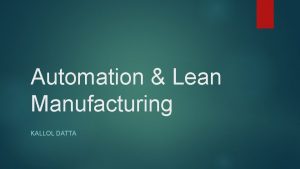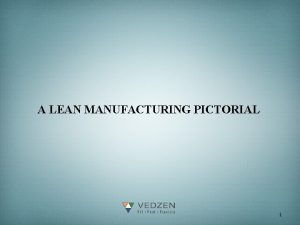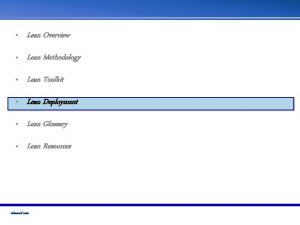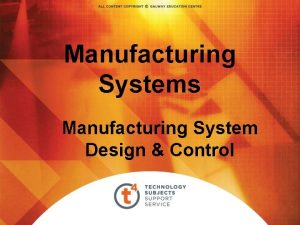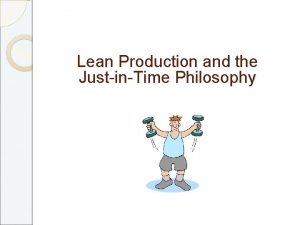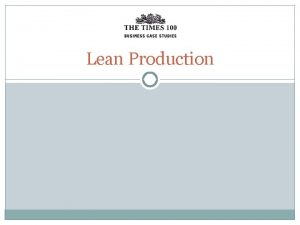Lean Production 2 Advanced Manufacturing System 1202022 Lean




















































- Slides: 52

Lean Production

2 Advanced Manufacturing System 1/20/2022 Lean Production • a production type that consists no unnecessary component and failure, cost, inventory, production area, loss and customer displeasure at minimum level in its structure. • In production and management, lean production uses “no mistake”, “continuous improvement”, “perfection”, “attendance of workers” and “ just in time” for describing its production style

3 Advanced Manufacturing System 1/20/2022 What is Lean Production? • Lean production means doing more work with fewer resources • Adaptation of mass production in which work is accomplished in less time, smaller space, with fewer workers and less equipment • Based on the Toyota Production System ▫ The term "lean production" was coined by researchers at Massachusetts Institute of Technology

4 Advanced Manufacturing System 1/20/2022 Properties of Lean Manufacturing • It is a sum because: ▫ In every level of organization, it consists of the attendance of all workers and the union of ideas and aims. ▫ It is implemented on all of the regions and activities of the firm. • It is quality because: ▫ It consists of the quality of managers’ and workers’ works. ▫ It consists of product and service quality. • It is control because: ▫ Error creators are determined instead of picking out errors and Main points are controlled ▫ Some systems are developed to prevent repetition of errors.

5 Advanced Manufacturing System 1/20/2022 Elements of Lean Production • Reduction of Process Lead Times • Faster turnaround ▫ an important factor of lead time in any project ▫ improve cycle time, smaller lot sizes, and flexibility • Improvement of Process and Product Quality to Zero Defects ▫ result in better quality ▫ improve customer perception and satisfaction • Minimization of Cost ▫ result in a cheaper and more competitive price ▫ time is the single most important factor of competitiveness • Inventory Reduction ▫ important factor of Lean manufacturing—for instance, raw materials, work-in-process (WIP), and finished goods ▫ Lean manufacturing eliminates unnecessary processes, arranges the stages of continuous processes and uses continuous improvement techniques provides better inventory control.

6 Advanced Manufacturing System 1/20/2022 Other Benefits • Improvement opportunities in the manufacturing system, such as product quality, productivity, customer service, capacity, inventory, WIP transportation in the system, flexibility, and process standardization (implementing the best process/operation techniques in completing project activities or tasks) • Reduction opportunities in the system of manufacturing consist of inventory, lot sizes, unit costs, design time, floor space, energy usage, and lead times (reduction of lead time and lead time variation to more consistent)

7 Advanced Manufacturing System 1/20/2022 Lean vs Traditional Lean Manufacturing Traditional Manufacturing Simple and Visual Complex Build to Demand Build to Forecast Minimal Inventory Excessive Inventory Focus on Non-Value Added Focus on Value Added Work Minimum Size Batch Processes Minimal Lead Times Long Lead Times Quality Through Process Quality Through Inspection Value Stream Owners Departmental Supervision

8 Advanced Manufacturing System 1/20/2022 Structure of Lean Production System • Taiichi Ohno's structure of the Toyota Production System

9 Advanced Manufacturing System 1/20/2022 Activities in Manufacturing • Actual work - activities that add value to the product • Auxiliary work - activities that support the value-adding activities • Muda (waste) - activities that neither add value nor support the value-adding activities

10 Advanced Manufacturing System 1/20/2022 Muda (Waste) • Taiichi Ohno’s seven forms of waste: ▫ Production of defective parts ▫ Production of more parts than needed (overproduction) ▫ Excessive inventories ▫ Unnecessary processing steps ▫ Unnecessary movement of people ▫ Unnecessary handling of materials ▫ Workers waiting

11 Advanced Manufacturing System 1/20/2022

12 Advanced Manufacturing System 1/20/2022

13 Advanced Manufacturing System 1/20/2022

14 Advanced Manufacturing System 1/20/2022 Over. Production • Parts are being produced without any new order or demand from the customer. • Questions related to overproductions: ▫ Why are you producing more than is requested by the customer? ▫ What storage problems and costs does it cause? ▫ Are you producing simply because you can—that is, because you have extra time and resources? ▫ How does this affect the line downstream?

15 Advanced Manufacturing System Over. Production 1/20/2022

16 Advanced Manufacturing System 1/20/2022 Wait Time • Caused by ▫ ▫ processing delays machine or system downtime response time signature required for approval wait time. • Some wait time value-added questions: ▫ Why is the delay happening? ▫ Are you waiting for materials, the next machine to be ready, or extra help to complete the job? ▫ What needs to change to make the flow smooth and even?

17 Advanced Manufacturing System Wait Time 1/20/2022

18 Advanced Manufacturing System 1/20/2022 Transportation • Transportation is defined as delivering to and from outside the factory warehouse facility. • The transportation of finished goods normally is generated by poor plant process or unnecessary plant process layouts. • Questions relating to transportation: ▫ Is all the current transport of materials really necessary? ▫ How far have materials or parts traveled from the previous process? ▫ How far to the next process? ▫ Can better process layout and/or storage solutions reduce your transport time and distance?

19 Advanced Manufacturing System 1/20/2022 Process • Storing work-in-process (WIP) products in further locations adds unneeded processing steps to complete the project and more. • Questions: ▫ Do you lose efficiency due to poor functioning tools and equipment? ▫ Do you need cleaning and repair, or does process require redesign? ▫ How much processing is done that is overkill by, for example, overgluing, polishing parts that are never seen, and so forth? ▫ Is each process step necessary? ▫ How much of your time is spent in rework?

20 Advanced Manufacturing System Process 1/20/2022

21 Advanced Manufacturing System 1/20/2022 Excess Inventory • Excess inventory is called storing excess products with no orders in the warehouse and having excess WIP. • Inventory value-added questions: ▫ Can you give a good reason for the extra inventory you have on hand? ▫ What about extra WIP? ▫ Is WIP pileup in certain areas unbalancing the line? ▫ What can you do about this?

22 Advanced Manufacturing System Inventory 1/20/2022

23 Advanced Manufacturing System 1/20/2022 Wasted Motions/Unutilized Talent • Movements that may cause injury in the manufacturing environment will result in process delay. • Other unutilized talents are employee lost time, unused skills, employee ideas, and recommendations in simplifying the process. • Questions to improve the process: ▫ How much walking do you do to complete an operation? ▫ Do you have to reach, bend, twist, or otherwise be uncomfortable to do processing or machine maintenance? ▫ How much time do you spend looking for things that get misplaced?

24 Advanced Manufacturing System 1/20/2022 Errors and Defects • Defects will additional rework, inspection (both expensive and time consuming), design changes, process changes, and machine downtime to analyze problems. • The original cost must be absorbed, and unnecessary rework or replacement costs need to be captured. • Defect-related questions: ▫ ▫ ▫ What are the causes of poor products? Are processing mistakes occurring too frequently? Are you getting poor materials? Are machines malfunctioning? How much scrap and rework is avoidable? How many issues are repeat problems?

25 Advanced Manufacturing System 1/20/2022 Seven Wastes and Their Solutions • Overproduction: reduce by producing only what is needed as it is needed. • Waiting: synchronize the workflow. • Transportation: minimize transport with better layouts. • Processing: “Why do we need this process at all? ” • Stock: reduce inventories. • Motion: reduce wasted employee motions. • Defective products: improve quality to reduce rework.

26 Advanced Manufacturing System Eliminating Waste 1/20/2022

27 Advanced Manufacturing System Eliminating Waste 1/20/2022

28 Advanced Manufacturing System Eliminating Waste 1/20/2022

29 Advanced Manufacturing System Eliminating Waste 1/20/2022

30 Advanced Manufacturing System Eliminating Waste 1/20/2022

31 Advanced Manufacturing System Eliminating Waste 1/20/2022

32 Advanced Manufacturing System Eliminating Waste 1/20/2022

33 Advanced Manufacturing System Eliminating Waste 1/20/2022

34 Advanced Manufacturing System 1/20/2022 Keys to Eliminating Waste • Just-in-time production • Autonomation (automation with a human touch) • Worker involvement

35 Advanced Manufacturing System 1/20/2022 Autonomation • “Automation with a human touch” • Production machines operate autonomously as long as they are functioning properly • When they do not function properly (e. g. , they produce a defect), they are designed to stop • Autonomation topics: ▫ Stop the process ▫ Error prevention ▫ Total Productive Maintenance (TPM)

36 Advanced Manufacturing System 1/20/2022 Stop the Process • “Jidoka” ▫ Japanese word meaning machines that are designed to stop automatically when something goes wrong • Stop the process when: ▫ Defective parts are produced ▫ Required production quantity has been completed �Avoids overproduction

37 Advanced Manufacturing System 1/20/2022 Error Prevention • “Poka-yoke” ▫ Japanese word meaning prevention of errors using low cost devices to prevent or detect them • Common mistakes in manufacturing: ▫ ▫ Omitting processing steps Incorrectly locating a part in a fixture Using the wrong tool Neglecting to add a part in assembly

38 Advanced Manufacturing System 1/20/2022 Poka-Yoke Functions • Performs 100% inspection for the following: ▫ ▫ Workpart deviations Processing and methods deviations Counting and timing functions Verification of steps during work cycle • When an error or other exception is identified, the poka-yoke responses are either or both of the following: ▫ Stops the process when an error or problem is detected ▫ Provides an audible or visible warning to alert operator and other workers

39 Advanced Manufacturing System 1/20/2022 Total Productive Maintenance • Goal: zero breakdowns • TPM = integration of preventive and predictive maintenance to avoid emergency maintenance ▫ Emergency maintenance = repair equipment that breaks down ▫ Preventive maintenance = routine repairs to avoid breakdowns ▫ Predictive maintenance = anticipating malfunctions before they occur

40 Advanced Manufacturing System 1/20/2022 Equipment Availability Curve • Typical U-shaped availability curve for a piece of equipment during its life

41 Advanced Manufacturing System 1/20/2022 Overall Equipment Effectiveness • Measure that includes availability (reliability), equipment utilization, yield of good product, and operating capability OEE = A U Y ros where: OEE = overall equipment effectiveness A = availability (proportion uptime) U = equipment utilization (time equipment is used relative to available time) Y = yield of good product = 1 - q, where q = fraction defect rate ros = operating capability (actual speed / design speed)

42 Advanced Manufacturing System Worker Involvement • Components: ▫ ▫ Continuous improvement Visual workplace Standard work procedures Total productive maintenance 1/20/2022

43 Advanced Manufacturing System 1/20/2022 Continuous Improvement • “Kaizen” ▫ Japanese word meaning continuous improvement of production operations • Usually implemented by worker teams, sometimes called “quality circles” ▫ Encourages worker sense of responsibility ▫ Allows workers to gain recognition among colleagues ▫ Improves worker’s technical skills

44 Advanced Manufacturing System 1/20/2022 Visual Management and 5 S • Principle: the status of the work situation should be evident just by looking at it ▫ Objects that obstruct the view are not allowed ▫ Build-up of WIP is limited to a specific height ▫ Andon boards located above the assembly line indicate the status of the workstations ▫ Worker training includes use of photos and diagrams to document work instructions

45 Advanced Manufacturing System 1/20/2022 Worker Involvement through 5 S Japanese word English equivalent • • • Seiri Seiton Seiso Seiketsu Shitsuke Sort Set in order, simplify access Shine, sweep, scrub Standardize Self-discipline, sustain

46 Advanced Manufacturing System 1/20/2022 Standardized Work Procedures Three components: • Cycle time – actual time required ▫ “Takt time” – reciprocal of demand rate adjusted for available shift time • Work sequence ▫ Basically the same as a standard method • Standard work-in-process ▫ Minimum number of parts to avoid waiting of workers

47 Advanced Manufacturing System 1/20/2022 Takt Time and Cycle Time • Takt time defined Ttakt = EOT / Qdd where: ▫ Ttakt = takt time ▫ EOT = effective daily operating time ▫ Qdd = daily quantity demanded • In the Toyota Production System, the work must be designed so that the operation cycle time is consistent with the takt time

48 Advanced Manufacturing System 1/20/2022 Standard Operations Routine Sheet • Shows the machines that must be visited by the worker during each work cycle

49 Advanced Manufacturing System 1/20/2022 U-shaped Work Cell • Allocation of work at nine machines between three workers in a production work cell

50 Advanced Manufacturing System 1/20/2022 Operations Routine Sheets • Allocation of work at nine machines for three workers in a production work cell

51 Advanced Manufacturing System 1/20/2022 Standard Work-In-Process Quantity • Defined as the minimum number of parts necessary to avoid workers waiting • Factors that affect the standard WIP quantity: ▫ If quality inspections must be performed as distinct steps, then additional parts must be provided ▫ If processing includes heating of parts, then additional parts must be provided for heating and cooling time ▫ If the worker's work sequence is in the opposite direction of the part processing sequence, then at least one workpart must be held between machines to avoid waiting time

52 Advanced Manufacturing System End of this Chapter 1/20/2022
 Jit in operations management
Jit in operations management Pre production flow chart
Pre production flow chart Manufacturing cost vs non manufacturing cost
Manufacturing cost vs non manufacturing cost Process costing definition
Process costing definition Controllable costs
Controllable costs Manufacturing cost vs non manufacturing cost
Manufacturing cost vs non manufacturing cost Additive manufacturing vs subtractive manufacturing
Additive manufacturing vs subtractive manufacturing Ct advanced manufacturing
Ct advanced manufacturing Advanced manufacturing office
Advanced manufacturing office Advanced manufacturing process
Advanced manufacturing process Poka-yoke
Poka-yoke D365 manufacturing execution
D365 manufacturing execution Lean manufacturing malaga
Lean manufacturing malaga Lsw leader standard work
Lsw leader standard work Jit and lean operations
Jit and lean operations Lean manufacturing conclusion
Lean manufacturing conclusion Decd
Decd Lean manufacturing visual factory
Lean manufacturing visual factory System ssący i pchający
System ssący i pchający Mtlemine
Mtlemine Cip lean manufacturing
Cip lean manufacturing Lean cellular manufacturing
Lean cellular manufacturing Lean andon
Lean andon Lean manufacturing consultancy
Lean manufacturing consultancy Karta kanban wzór
Karta kanban wzór Lean manufacturing definition
Lean manufacturing definition Lean manufacturing definition
Lean manufacturing definition Tpm lean
Tpm lean Lean manufacturing competitiveness scheme
Lean manufacturing competitiveness scheme Lean manufacturing jelentése
Lean manufacturing jelentése Obeya adalah
Obeya adalah Example of production plan
Example of production plan Lean production and quality management
Lean production and quality management Zehnder rittling
Zehnder rittling Fms components
Fms components Define flexible manufacturing
Define flexible manufacturing Example of fms
Example of fms Limitations of fms
Limitations of fms Flexible manufacturing system history
Flexible manufacturing system history Objectives of flexible manufacturing system
Objectives of flexible manufacturing system Fachhochschule frankfurt am main
Fachhochschule frankfurt am main Advanced power system
Advanced power system Sitecore modules
Sitecore modules Explain advanced macro facilities with example
Explain advanced macro facilities with example Faa advanced automation system failure
Faa advanced automation system failure Assembler in system programming
Assembler in system programming Operating systems lecture notes
Operating systems lecture notes Emergency braking preparation
Emergency braking preparation Advanced field artillery tactical data system (afatds)
Advanced field artillery tactical data system (afatds) Assembler
Assembler Advanced train management system
Advanced train management system Ricart agrawala algorithm code in java
Ricart agrawala algorithm code in java Advanced operating system
Advanced operating system
